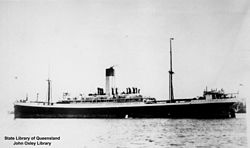Aeneas (ship, 1910)
|
||||||||||||||||||||
|
||||||||||||||||||||
|
||||||||||||||||||||
|
||||||||||||||||||||
|
||||||||||||||||||||
The Aeneas (I) was a 1910 passenger ship of the British shipping company Blue Funnel Line , which carried passengers and cargo from Great Britain to Australia . On July 4, 1940, the Aeneas sank after a German air raid in the English Channel off the coast of Devon . 19 people died.
The ship
The 10,049 GRT steamship Aeneas and the two identical sister ships Ascanius (II) (10,048 GRT) and Anchises (III) (10,046 GRT) were the first passenger ships of the Blue Funnel Line. They were ordered from Workman, Clark & Company in Belfast in 1908 for the shipping company's Australian service and each displaced more than 10,000 gross registered tonnes (GRT). They were considered pioneers on the Australian route. According to the criteria of the Lloyd's Register of Shipping , the three steamers were class A.
The 150.3 meter long and 18.4 meter wide passenger and cargo ship had a chimney, two masts and two propellers and was powered by a triple expansion steam engine that developed 641 hp and allowed a speed of 14 knots. The three ships were each designed to carry 288 passengers in first class. The Aeneas was launched on August 23, 1910 and was the first of the three ships to be completed. On November 18, 1910, she ran from Glasgow on her maiden voyage via Liverpool , Fishguard , Las Palmas and Cape Town to Adelaide , Melbourne and Sydney . The departures took place every six weeks and lasted 39 days.
After the outbreak of World War I in 1914, the Aeneas with the identification A60 was used by the Australian government as a troop transport. On October 5, 1915, she left with the 10th Division in Egypt for Thessaloniki . Two days later, she collided with an anti-mine vehicle in a severe storm . On October 10th, she arrived in Thessaloniki after a stopover on Moudros . In May 1918 she ran aground near Torcor Head on Rathlin Island . After the end of the war she was returned to the shipping company and returned to Australian service on May 29, 1920 with space for 180 first class passengers. From 1924 the ship was used in a joint venture in cooperation with the White Star Line . In the following year she was laid on the Far East route and joined the ships of the Sarpedon class.
Sinking
On July 2, 1940, the Aeneas was under the command of Captain DLC Evans as part of convoy OA-1776 en route from London to Glasgow, when she was 21 nautical miles southeast of the start point on the coast of the English county of Devon from German fighter-bombers was attacked. As the largest ship in the convoy, it was specifically selected for a bombing raid and was also placed under machine gun fire.
One of the aerial bombs destroyed the main steam pipe and tore open the starboard side of the ship. The bomb exploded deep inside the ship, killing 19 machinists and stokers. Captain Evans ordered abandon ship while Aeneas list accepted. The survivors were taken in by the Worthington . Two days after the attack, on July 4, 1940, the Aeneas capsized and sank.

